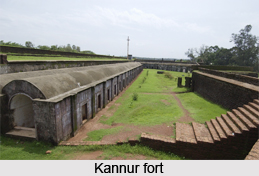 The monuments of Kerala have well preserved the history and culture of the state. Popularly known as `God`s own country`, the state of Kerala has a rich array of historical and religious monuments that dot the lush landscape of this beautiful state and make it a travellers paradise.
The monuments of Kerala have well preserved the history and culture of the state. Popularly known as `God`s own country`, the state of Kerala has a rich array of historical and religious monuments that dot the lush landscape of this beautiful state and make it a travellers paradise.
Modern day Kerala was created in 1956 along linguistic lines. It has been under the rule of a number of different dynasties including the Cheras, the Ays, the Pandyan rulers, the Kulashekar dynasty and later the British. Marthanda Varma is said to be the father of modern Kerala as the state grew and developed to a great extent under him. Kerala being located on the seacoast was the centre for trade and commerce. As a result a number of different merchants from West Europe, Southern Asia etc. established close ties and settlements here. Thus in the monuments of Kerala is reflected not only the grandeur of the various dynasties that held sway here but also many outside influences that entered India via Kerala.
The monuments of Kerala are chiefly constructed in the traditional style of nallukettu or ettukettu-four or eight sided structures with a central courtyard and walls opening out. However, in regions like fort Kochi which has seen a great mix and confluence of cultures, the architecture is a curious mix of typical Kerala, European, Chinese, Jewish and Arabic styles. The various monuments of Kerala include temples, churches, palaces, mosques, forts and mansions.
Prevalent in Kerala is a happy blend of various religions like Hindu, Christian, Muslim as well as Jew. Thus among the monuments of Kerala one can find a heterogeneity of worship, for instance Chottanikkara Temple, Guruvayoor Temple, Sabbatical Temple, Vadakkumnathan Temple, Cheraman Juma Masjid, Saint Sebastian Church, The Churches at Muttuchira, Aranmula Temple and Jewish Synagogue among others.
Significant monuments of Kerala
Chief among the monuments of historical interest are the Bolghatty palace, Alwaye palace, Mattencherry palace, Krishnapuram Palace, Bekal Fort, Hill palace museum, Arrakal palace and Kannur fort, Chittur Garumadam and many more described below.
Bekal Fort
Bekal fort, in Kasargod, stands like a mysterious guard holding his watch over the vast Arabian shoreline. It is undoubtedly the largest and best-preserved fort in Kerala. Also the water-tank with its stairway, a mosque and a Hanuman temple at the entrance adds to its magnificence.
Poonjar Palace
Poonjar Palace in Meenachil taluk is a glorious testimony to the regal opulence of a bygone era. With the palace walls, is an extra ordinary collection of antiques which include a palanquin, a thoni carved out of a single wood for Ayurvedic massages, huge chandeliers, palm leaf engravings, jewel boxes, a variety of lamps, sculptures of Nataraja, grain measures, statues and weapons.
St.Francis Church
St.Francis Church is the first European Church built in India and is located on Parade Road in Fort Kochi. It was originally named Santo Antonio, the patron Saint of Portugal. The Church portrays the period of European colonial power. It was in fact formerly a fort built in 1503 by Alphonso Albuquerque, after gaining the Rajah of Cochins permission.
Fort Kochi
Fort Kochi is known for its Dutch, Portuguese, and British colonial architecture. This former Portuguese bastion, built in 1503, is a sign of the strategic alliance between the Maharaja of Cochin and the Portuguese Monarch.
Thalassery Fort
This fort which is at the heart of Thalassery city, was, in fact, the military center of the British, and is one reminder of their colonial imperialism. The East India Company constructed it housing secret tunnels, carved doors, and two underground chambers.
Thrikkakudi Rock-Cut Temple
The Kaviyoor Thrikkakkudi Cave Temple is an ancient temple carved on a massive rock located at Kaviyoor near Thiruvalla in the Pathanamthitta district. Dedicated to Lord Shiva, this temple has an archaeological importance because of its close similarity to the Pallava style of architecture.
Krishnapuram Palace
Krishnapuram Palace is a palace and museum located in Kayamkulam near Alappuzha in Alappuzha district. It was built in the 18th century by Anizham Thirunal Marthanda Varma of the Travancore kingdom. It is built in the architectural style of Kerala with gabled roof, narrow corridor and dormer windows, near the Krishnaswamy Temple at Krishnapuram.
Anchuthengu and Anjengo Fort
Anjuthengu means five coconut trees in Malayalam. The British called it Anjengo fort for their ease, and the East India Company built it during the 17th century. It was the first major trading station of the East India Company, making it historically significant.
Paradesi synagogue or Jewish synagogue
Jewish synagogue or Paradesi synagogue contains relics like Belgian glass chandeliers; brass railed pulpits, gold crowns and copper plates made in the 10th century. The floor is made up of 18th-century handcrafted porcelain tiles of China, and every single tile is different.
Kannur fort
St. Angelo Fort, also known as Kannur Fort or Kannur Kotta is a fort facing the Arabian Sea, situated 3 km from Kannur, a city in Kerala. Built by the first Portuguese Viceroy in India, Don Francesco de Almeida (1505), St. Angelo`s Fort is among the most historic sites in Kerala.
Mattencherry Palace
Mattancherry Palace is a Portuguese palace popularly known as the Dutch Palace, in Mattancherry, Kochi. It features Kerala murals depicting portraits and exhibits of the Rajas of Kochi. The palace was included in the "tentative list" of UNESCO World Heritage Site.
Thus, the monuments of Kerala are varied in their style, significance and history. All of them contribute towards making Kerala a real tourist`s delight.




